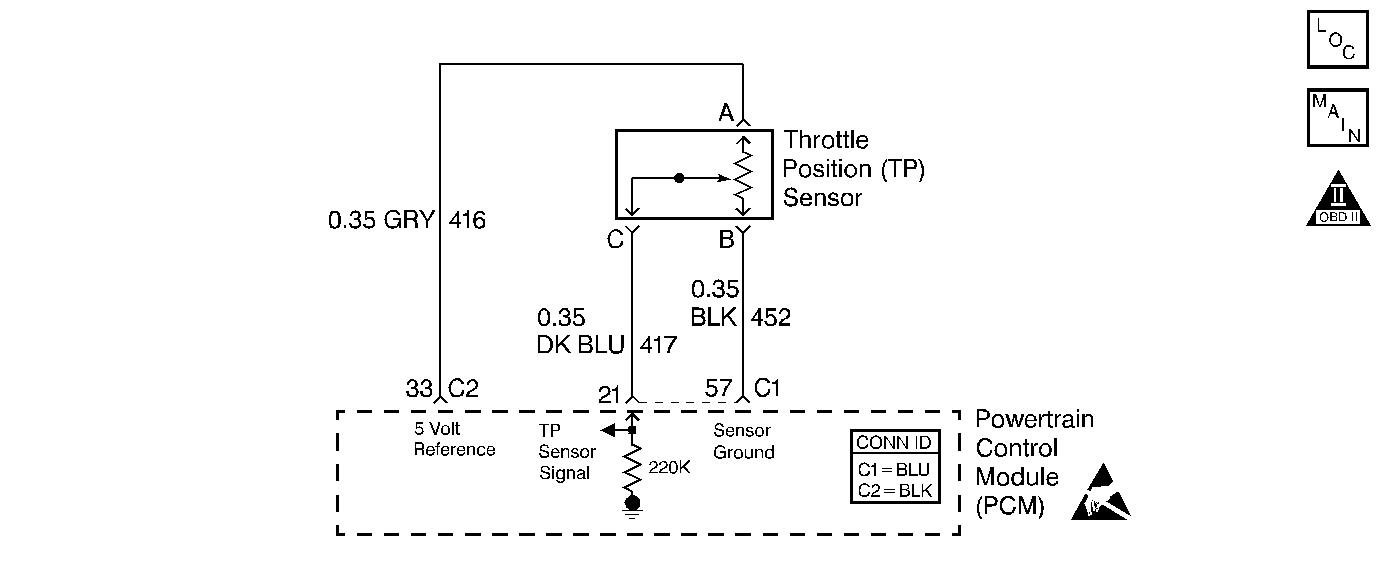
Circuit Description
The Powertrain Control Module (PCM) supplies a 5.0 volt reference signal and a ground to the sensor. The TP sensor sends a voltage signal back to the PCM relative to the throttle plate opening. The voltage will vary from approximately 0.35 volt at closed throttle, to more than 4.65 volts at wide open throttle (WOT).
Conditions for Running the DTC
| • | DTCs P0107 or P0108 are not set. |
| • | The engine is running. |
| • | The MAP is less than 60 kPa. |
| • | The engine speed is less than 1500 RPM. |
| Or |
| • | DTCs P0107 or P0108 are not set. |
| • | The engine is running. |
| • | The MAP is more than 60 kPa. |
| • | The engine speed is more than 1500 RPM. |
Conditions for Setting the DTC
| • | The TP sensor voltage is more than 3.9 volts for 13.75 seconds when the engine speed is less than 1500 RPM. |
| • | The TP sensor voltage is more than 4.8 volts when the engine speed is more than 1500 RPM. |
Action Taken When the DTC Sets
| • | The malfunction indicator lamp (MIL) will illuminate after two consecutive ignition cycles in which the diagnostic runs with the fault active. |
| • | The PCM will record the operating conditions at the time that the diagnostic fails. This information will store in the Freeze Frame and Failure Records buffers. |
| • | A history DTC stores. |
| • | The coolant fan turns ON. |
| • | The TP angle will default to 0 percent when the vehicle speed is less than 3 km/h (2 mph) and 10 percent when the vehicle speed is more than 3 km/h (2 mph) (The scan tool will display the defaulted value). |
Conditions for Clearing the MIL/DTC
| • | The MIL will turn OFF after three consecutive ignition cycles in which the diagnostic runs without a fault. |
| • | A history DTC will clear after 40 consecutive warm-up cycles without a fault. |
| • | Use a scan tool to clear the DTCs. |
Diagnostic Aids
If DTC P0123 cannot be duplicated, the information included in the Freeze Frame data can be useful. Use the scan tool DTC information data to determine the status of the DTC.
With the ignition ON and the throttle at closed position, the voltage should read between 0.20- 0.90 V. Voltage should increase steadily to more than 4.5 V at wide open throttle.
Test Description
The numbers below refer to the step numbers in the diagnostic table.
-
If the throttle position (TP) signal measures more than 4.8 volts, then the condition exists.
-
With the TP sensor disconnected, and if the PCM and the wiring are okay, the TP signal should be less than 0.25 volt. This test could set a DTC P0122.
Step | Action | Value(s) | Yes | No |
|---|---|---|---|---|
1 | Did you perform the Powertrain On-Board Diagnostic (OBD) System Check? | -- | ||
Does the scan tool display a TP sensor voltage that is more than the specified value? | 4.7 V | |||
Does the scan tool display a TP sensor voltage less than the specified value? | 0.25 V | |||
4 | The DTC is intermittent. Are any additional DTCs stored? | -- | Go to Diagnostic Aids | |
5 | Measure the 5-volt reference circuit at the TP sensor harness connector with a DMM connected to a ground. Is the voltage more than the specified value? | 5.2 V | ||
6 | Probe the TP sensor ground circuit at the TP sensor harness connector with a test lamp connected to B+. Is the test lamp ON? | -- | ||
7 | Replace the TP sensor. Refer to Throttle Position Sensor Replacement . Is the action complete? | -- | -- | |
8 | Inspect for a short to voltage in the TP sensor signal circuit. Did you find a problem? | -- | ||
9 |
Is the voltage more than the specified value? | 0 V | ||
10 | Measure the voltage on the MAP sensor 5-volt reference circuit at the PCM C2 connector with a DMM connected to a ground. Is the voltage more than the specified value? | 0 V | ||
11 | Repair the open in the TP sensor ground circuit. Refer to Wiring Repairs in Wiring Systems. Is the action complete? | -- | -- | |
12 | Repair the circuit as necessary. Refer to Wiring Repairs in Wiring Systems. Is the action complete? | -- | -- | |
13 | Repair the short to voltage on the 5-volt reference circuit. Refer to Wiring Repairs in Wiring Systems. Is the action complete? | -- | -- | |
14 |
Important: Refer to Powertrain Control Module Replacement/Programming . Replace the PCM. Refer to Powertrain Control Module Replacement . Is the action complete? | -- | -- | |
15 |
Does the scan tool indicate the diagnostic Passed? | -- | ||
16 | Does the scan tool display any additional undiagnosed DTCs? | -- | System OK |
